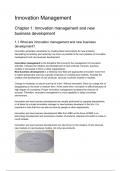Samenvatting
Samenvatting Innovatie Management
- Vak
- Instelling
- Boek
Samenvatting voor Innovation Management, Erasmus Universiteit, Rotterdam School of Management. Vat zowel het boek (Innovation Management, Jan van den Ende) als de lectures samen.
[Meer zien]





